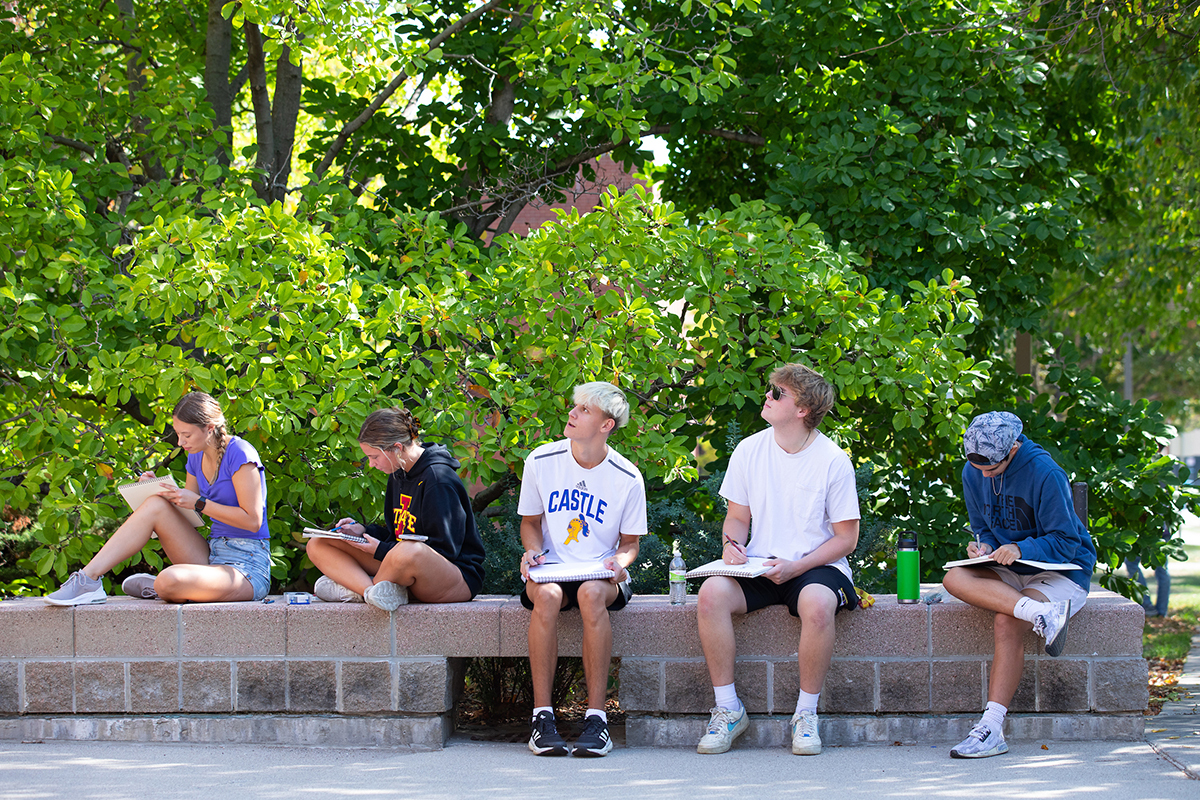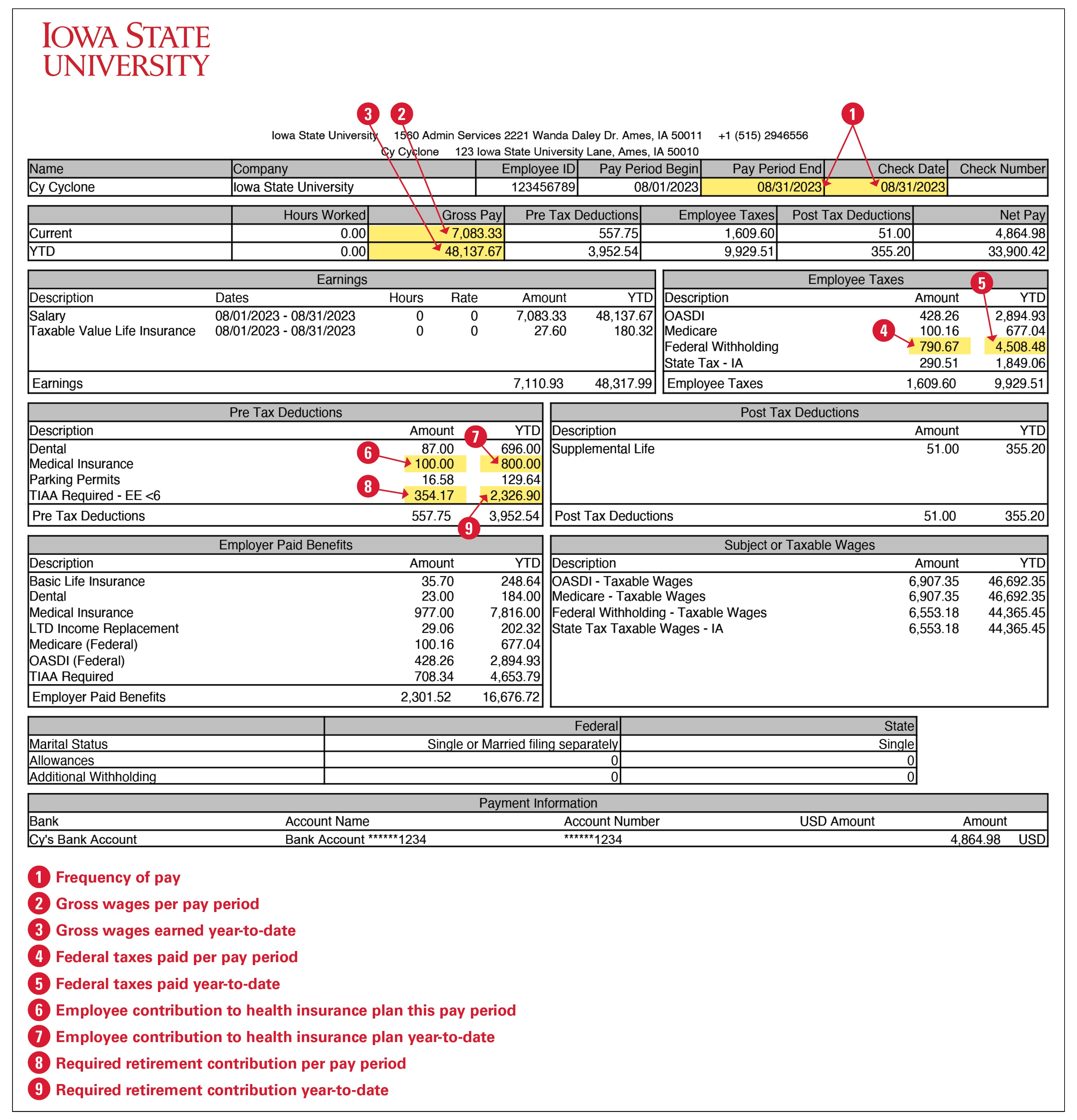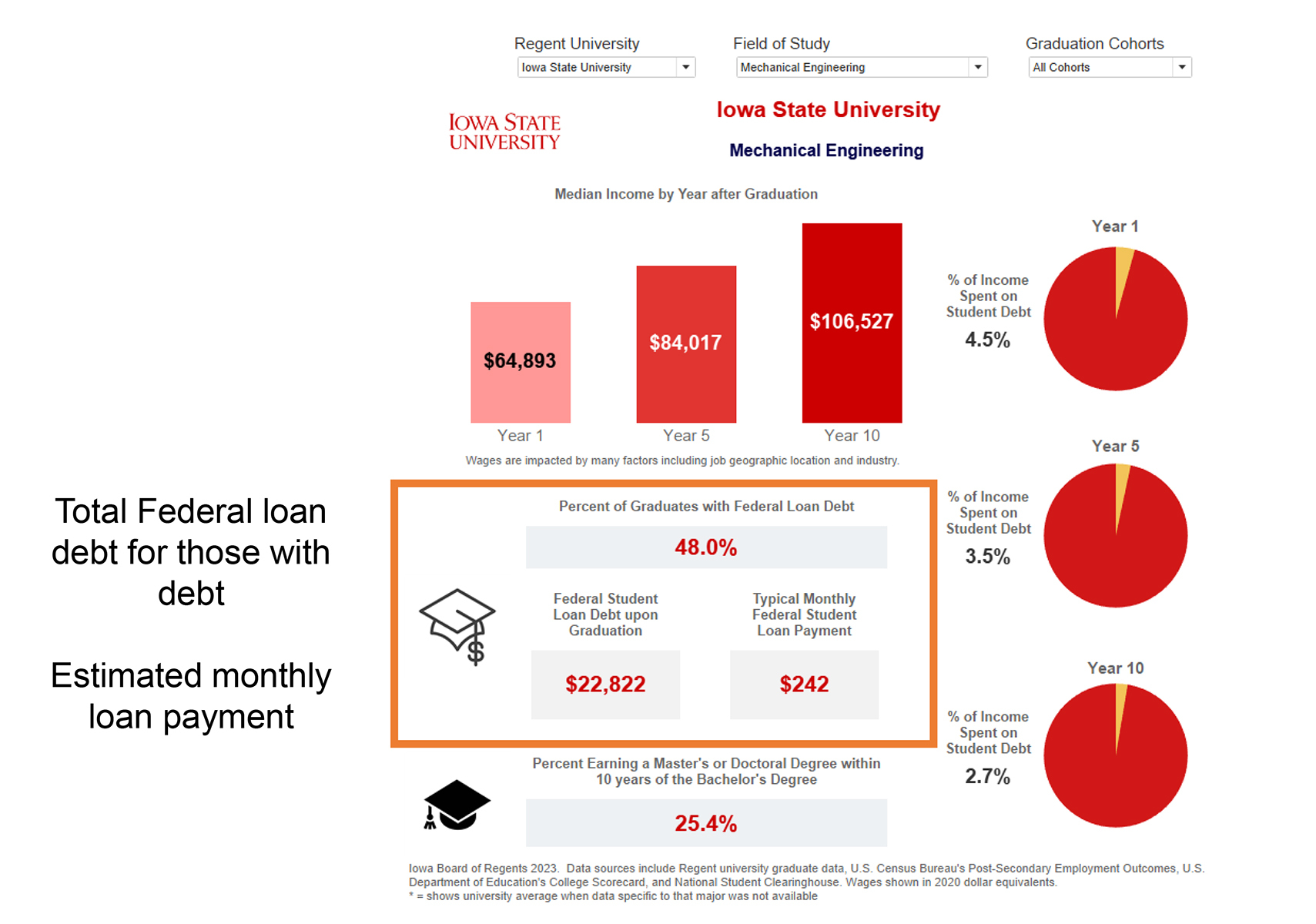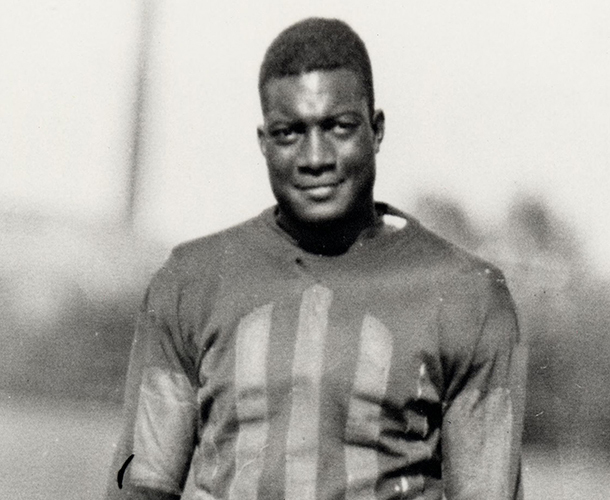No place better

Photo by Christopher Gannon.
Students in associate teaching professor Nathan Edwards' Fundamentals of Drawing class stopped on their Monday morning "sketch crawl" to consider the architecture and commissioned art on the south face of the Molecular Biology Building. Edwards, who teaches in the art and visual culture department, took advantage of summerlike days as September handed off to October for an outdoor classroom experience. He challenged his students to sketch patterns in building architecture and the landscape as well as their spatial relationships.
Questions and answers from the Oct. 4 benefits town hall
As part of a broader effort to help faculty and staff understand and prepare for changes to their medical insurance plans for 2024, benefits director Ed Holland and associate vice president for finance Heather Paris led a virtual town hall on Wednesday, Oct 4. During the town hall, they responded to faculty and staff participants' questions, many of which are summarized below. The town hall was recorded and archived. A link is on the benefits' open enrollment website (under "communications").
Why are we trying to bridge the health insurance cost gap in one year?
Actually, we're not. This effort will take a few years to fully close the gap, and the changes being made for 2024 are a first step. The university previously had reserves to help offset the gap between premiums collected and medical claims paid each year, but those reserves are now depleted. To maintain this health benefit for our employees, we must have a different strategy to share the full cost between employees and university departments.
It's difficult to predict what our plans will look like in 2025. We'll need to watch what happens with health care costs in the next year as well as how employees utilize the services in our plans.
What employee input was considered before making these changes?
The Employee Benefit Advisory Committee (EBAC) representatives are faculty, professional and scientific and merit employees. As it does every year, last spring, the members reviewed the information and options for plan changes they received from our health care consultant. They also were able to discuss the potential savings with their constituents. They then voted for this recommendation, which was taken to senior leadership.
Has the university considered a high-deductible health plan with a health savings account?
Yes, EBAC looks at those plans from time to time. Our plan is not a high-deductible plan, even after the changes we put in place for the upcoming year. For 2024, the deductible required by the IRS in a high-deductible plan is $1,600 (single coverage) and $3,200 (family). Those required deductible levels are more than our HMO out-of-pocket maximums for 2024. There still are premiums and even higher out-of-pocket maximums for those plans as well.
This question reflects the continuum among our employees -- some prefer a lower premium and potential higher out-of-pocket liability, and others prefer a lower liability for out-of-pocket costs with higher premiums.
Has Iowa State considered setting premiums based on the number of people covered in a plan?
We actively review the employee benefits market for new ways to offer plans and to develop our premiums. Typically, what we see in the market is the four tiers we offer. Sometimes we see fewer tiers; it is rare to see more tiers than we offer. There likely is little value in offering additional tiers of coverage.
Will counseling and therapy sessions still be covered in 2024?
No changes are being made to ISU's overall health care coverage. Your health care benefits will continue to include mental health and substance abuse services. What is changing is that now you will pay a copay each time you visit a provider for these services. If you're in the HMO plan, the copay is $15 per visit. If you're in the PPO plan, the copay is $25 per visit. Beyond the copay, you will not pay additional expenses for these services. Every copay counts towards your annual out-of-pocket maximum. If you reach your out-of-pocket maximum at any time in 2024, you'll no longer pay a copay the rest of the calendar year.
With the growing concern for employee mental health, why is that not considered preventive care?
There are multiple mental health screenings that fall under preventive care services that are at no cost to our employees and their dependents. The federal government determines what's defined as preventive services (under the 2010 Affordable Care Act), and that list has grown since 2010.
Why does this plan have coinsurance if ISU is already adding a deductible?
This arrangement is standard in health insurance plans. Early in the plan year, you're paying the full cost of the (nonpreventive) services you receive; your deductible is a dollar amount you need to reach. Once you meet it, there still are out-of-pocket costs, but now you switch to paying a percentage of the cost of services (10% co-insurance in the HMO plan, 20% in the PPO plan). The co-insurance is how you get from your deductible to your annual out-of-pocket maximum.
Two educational tools are available to help employees. On the UHR Benefits website, the Medical Insurance Glossary and Understanding Your Medical Coverage Costs video help define plan elements such as a deductible, coinsurance and out-of-pocket maximum, as well as how these elements interact and apply to care received.
Do office copays count toward the deductible or the out-of-pocket maximum?
On the ISU Plan, our co-pay is inclusive, so when you have an office copay, there isn't a deductible requirement. However, copays, the deductible and coinsurance all count towards the out-of-pocket maximum.
What's the difference between an office visit copay and an emergency room copay?
In an office visit copay, coinsurance does not follow. The lone exception is when you go to the emergency room. You will have a copay of $125, plus you'll pay coinsurance for the services you receive in the ER. Coinsurance is 10% (HMO) or 20% (PPO).
Do employees have to reach their deductible before coinsurance begins?
Yes, you must meet your deductible. Once you do, coinsurance kicks in and you only pay coinsurance. A couple of exceptions are:
- When you pay a copay, you don't have to pay toward the deductible.
- Under family coverage, when an individual in the family meets the $250 deductible, from that point forward, that family member pays coinsurance. An individual in a family plan doesn't have to meet the $500 family deductible.
Is the pharmacy benefit changing?
No, the pharmacy plan isn't changing. Everything about how that portion of the plan works for employees will continue. You will pay whatever the copay or coinsurance is, depending on what tier of drug you receive. Whatever you pay goes toward the pharmacy out-of-pocket maximum (which is separate from the medical out-of-pocket maximum).
Can ALEX pull in an employee's health care spending history to help with planning for the upcoming year?
The ALEX tool asks questions about your history, and your claims history is available to you in your mywellmark.com account. When you enter your health care spending information into ALEX, it will base its recommendations on what you provide.
With the ALEX GO app version, you also can enter the information for a spouse's health care plan (with another employer), and your comparison will consider Iowa State's HMO and PPO plans as well as the spouse's plan.
If labs or additional services are ordered during my office visit but not available to me that day, do I pay another copay when I return for them?
The copay reflects date of service. So, if you return later that day for services, the copay would apply. But if you return on another day, depending on how the provider bills it, you could pay a copay or co-insurance for that service.
How soon can I use the money in my health care flexible spending account?
On Jan. 1, you have access to the full amount you have elected to put into your account. One caveat: The reimbursement comes from our vendor, ASIFlex, so there might be a slight delay in you receiving that money until ASIFlex receives ISU's first payment.
How do these plan changes impact ISU retirees?
Our expectation -- and the message we're sharing with our retirees -- is that very little of these plan changes will impact retirees because nearly all our retirees are Medicare-eligible. For them, Medicare pays first.
Learn more:
- Study the 2024 plan details in the Open Enrollment section of the benefits website. This includes documents, a video and slide set.
- Ask a benefits specialist. Call 294-4800, email benefits@iastate.edu, or schedule a meeting through the online scheduler, Bookings.
- Watch for the Oct. 12 edition of Inside Iowa State, which will highlight helpful examples and information.
Avoid a tax surprise with a paycheck check-up

Graphic design by Deb Berger. Larger image
One way to avoid a surprise during the next tax season is to take time now for a paycheck check-up. Making sure the right amount of taxes are being taken out of a paycheck each month could keep employees from writing a check later.
More information
The IRS provides information on withholding and how to ensure you get it right.
Federal tax withholding
The Internal Revenue Service (IRS) has a withholding estimator to help employees calculate their federal tax withholdings. The tool:
- Estimates federal income tax withholding
- Shows how a refund, take-home pay or tax are affected by the withholding amount
- Helps determine the withholding amount that works for the employee
The estimator requires payslips for all jobs (and those of a spouse), income information for side jobs, self-employment, investments, etc. and your most recent tax return. The estimator is as accurate as the information provided and no financial information is saved. Payslips can be found in Workday under the "pay" icon.
"There still is time to make changes that will make an impact," said senior payroll manager Teri Kruse. "Withholding too little from a paycheck could mean an unexpected tax bill or penalty. We ask everyone to take the time and look at their payslip."
Kruse said it is a good practice for employees to review their payslip monthly, looking at tax and benefit information, for accuracy.
State tax withholding
Employees also can calculate the appropriate withholding for state taxes using a withholding estimator. The 2022 Iowa Legislature simplified Iowa's personal income tax structure from nine rates in 2022 to four this year. The two critical variables in how much tax employers withhold are salary and the tax elections an employee sets in their W-4 form. In both 2024 and 2025, the highest rate will be eliminated, so in 2026 Iowa will have a single rate possibly necessitating future adjustments.
The W-4s
Employees can confirm their state and federal withholdings in Workday under the "pay" icon (among "actions," select "withholding elections"). They can change their Iowa W-4 or federal W-4, both of which also are available in Workday. But complete your calculations first; once you click "update" for either form, the previous tax elections are gone. The W-4 can be changed anytime and as often as necessary. A knowledge base article explains how to update withholding elections.
Employees with questions about filling out the tax estimators or a W-4 form can contact payroll@iastate.edu or call 294-6556. Employees are encouraged to talk to a professional tax advisor about adjusting their withholdings, Kruse said.
LeBaron Hall replacement plan gets the green light
The College of Human Sciences will proceed with plans to demolish and replace LeBaron Hall, following final approval of its project budget and building schematics Sept. 28 by the state Board of Regents.
The new LeBaron Hall will be 30,000 square feet of classrooms and production laboratories designed with greater flexibility to adapt to needs as the apparel and event management industries change. The project adds a 100-seat classroom to the general university inventory and also renovates the commons area connecting LeBaron and MacKay halls and the Human Nutritional Sciences Building. The southern end of the current LeBaron footprint will be reserved for a possible addition to the new building. The $39 million project will be paid for with $30.4 million in private gifts and $8.6 million in university funds.
Construction would begin next summer and conclude during summer 2026.
Iowa State also received permission to begin planning for a second remodeling project in the adjacent Human Nutritional Science Building to create new homes for the student-operated Joan Bice Underwood Tea Room (first floor) and the textiles science teaching laboratory (second floor). In April, the board approved plans to relocate other textiles science labs from LeBaron Hall.
Other building projects
The board also approved Iowa State proposals to:
- Renovate part of the east end of the Scheman Building, including the ground floor main entrances, entry lobbies and restrooms; and circulation areas, restrooms and Benton Auditorium on the first floor. The project adds food and beverage service areas and upgrades electrical and mechanical systems. The $12 million project budget will be paid for with ISU Facilities Corporation Bonds. The construction window is spring 2024 through summer 2025.
- Remodel the food service and back-of-house areas and restrooms at Seasons Marketplace in the Maple Willow Larch residence complex commons. The $2.45 million project budget will be funded by ISU Dormitory Bonds. This work will be done next summer.
-
Remodel the athletics department's Bruce McKee Indoor Tennis Complex on South Dakota Avenue to be the training facility for the Cyclone volleyball program. The $4.2 million project budget will be funded by department funds. The construction window is summer 2024 through spring 2025.
To accommodate this project, the tennis team needs to relocate. Instead of leasing a tennis facility in the ISU Research Park from Ames Racquet and Fitness Center, a plan the regents approved last fall, the ISU Research Park will purchase the fitness center's existing four-court facility, add two indoor and six outdoor courts, and lease the tennis complex to the athletics department for the Cyclone tennis program.
New dashboard: Student income and debt

Prototype of the Iowa State version of a student data dashboard required by the 2023 Iowa Legislature. Larger image.
Jason Pontius, associate chief academic officer on the board's staff, shared with board members details and a prototype of a new student data dashboard required by the 2023 Legislature. House File 135 requires the three regent universities to share income and student debt data on alumni who completed undergraduate degrees. The intent is to show students the costs associated with higher education and the average salaries they could earn after graduating. Each university will annually post:
- Median annual income of students one, five and 10 years after completing their undergraduate degrees.
- Median student loan debt of students with debt who completed their undergraduate degree. Pontius noted that across the three schools, roughly 40% of undergraduates graduate without debt. (At Iowa State, the numbers are a bit higher. About 42% of Iowa residents and 44% of nonresident undergraduates have no debt at graduation.)
- Ratio of the student loan debt to those students' annual gross incomes.
- Estimate of the required monthly student loan payment, expressed as a percentage of the student's monthly gross income.
- Percentage of students who complete a master's or doctoral program within 10 years of completing an undergraduate program.
The legislation requires the universities to share this information annually with students "in the process of completing their first year of a baccalaureate program." Users will be able to filter the data by field of study -- not quite as precise as a major, but similar.
Pontius said the communications plan is that universities will share the information with all their students via email for the first time before the end of spring 2024 semester. The data will be updated annually in July on career services' statistics website and provided to students at least once a year. All three universities' data also will be on available on the board's website.
Pontius said the data for the dashboard will come primarily from three sources: the U.S. Census Bureau's Post-Secondary Employment Outcomes (wages), U.S. Department of Education's College Scorecard (student debt), and the National Student Clearinghouse (graduate degrees).
State operating support for next year
Iowa State is asking for a $4.5 million (2.5%) increase to its current $174.1 million operating appropriation from the state for fiscal year 2025. With an amendment proposed by student regent Abby Crow of the University of Iowa, the board will ask the state for $1 million in new operating funds to address student mental health on the three campuses.
President Wendy Wintersteen also outlined a proposal for an additional $10 million (total of $12.8 million) for year two of STEM workforce programming. The funds would target three areas: strengthen degree programs that align with Iowa's "Hot 50" jobs and key STEM fields; support Iowa manufacturers, particularly in biomanufacturing and opening international markets; and strengthen extension programming to boost the vitality of rural communities to attract and retain workforce talent. Wintersteen said extension leaders will work with community leaders to identify the local needs in extension strengths such as child care, health care, housing, transportation or economic development.
The three universities will ask for a $30 million capital commitment annually in the Rebuild Iowa Infrastructure Fund, to which the schools would add a 50% match. The funds would be allocated by the board for building renewal projects -- such as fire and environmental safety, campus security, regulatory compliance, energy conservation, modernization and building replacement. As a reference point, over the last five years, the three universities collectively spent an average of $32.3 million per year to reduce the current $1.4 billion building renewal backlog.
Special retirement option in LAS
Board associate counsel Kristen Bauer reported that 17 faculty in the College of Liberal Arts and Sciences were approved for a retirement incentive program that's part of the multiyear Reimagine LAS initiative to right-size the college and eliminate its operating deficit. Another three applicants subsequently pulled their applications, and one applicant was denied participation in the program. In April 2022, an estimated 127 college faculty were eligible to participate.
The net savings to the university (salary and benefits savings less the cost of the program) after four years (fiscal years 2023-26) is projected to be $7.8 million. Fifteen of the 17 participants selected two years of retirement contributions and health and dental coverage for their option; two chose the other option: three years of retirement contributions. All 17 faculty members retired by June 30 of this year.
In other Iowa State business, the board:
- Directed board staff members to update and administer the biennial Free Speech Survey for the 2023-24 academic year. Board policy calls for the regents to survey all university faculty, staff and students on First Amendment matters in their campus environment. The survey was first conducted in November 2021.
- Approved employee health and dental insurance rates for Jan. 1.
- Approved discontinuing the B.A. in speech communications program due to declining interest from students. Those in the program will have a three-year route to completing their degrees.
Leadership development group is underway
Iowa State's Emerging Leaders Academy (ELA) has welcomed 32 faculty and professional and scientific staff, chosen to participate in the program's 13th cohort.
ELA, established in 2009, is an academic-year professional development program designed to help new and aspiring campus leaders build their skills, better understand university function and culture, and think beyond their department or unit. Participants attend monthly sessions on topics such as leadership theory and practice, organizational environment and culture, budgeting, communications and ethics.
The 2023-2024 cohort members are:
- Alice Alipour, civil, construction, and environmental engineering
- Mitch Amundson, Ames National Laboratory
- Rizia Bardhan, chemical and biological engineering
- Karen Bramow, office of the vice president for research
- Steve Butler, mathematics
- Christian Carichner, music and theatre
- Matthew Carver, Center for Excellence in Learning and Teaching
- Rita Case, Military-Affiliated Student Center
- Chunhui Chen, physics and astronomy
- Amy Crabbs, ISU Alumni Association
- Katy Cran, office of the senior vice president for student affairs
- Mridul Datta, food science and human nutrition
- Kristi Dillon, office of the senior vice president for operations and finance
- Alison Doyle, ISU Research Park
- Jason Follett, College of Engineering administration
- Susan Harper, Center for LGBTQIA+ Student Success
- Bonar Hernandez, history
- Robin Jones, College of Liberal Arts and Sciences administration
- Megan Myers, world languages and cultures
- Michael Olson, facilities planning and management
- Erin Olson-Douglas, College of Design and ISU Extension and Outreach
- Rahul Parsa, finance
- Sara Pistolesi, chemistry
- Amy Rutenberg, history
- Stacy Sassman, procurement services
- Yuko Sato, veterinary diagnostic and production animal medicine
- Doug Smith, School of Education
- Jenny Smith-Wittrock, kinesiology
- Angie Strotman, strategic relations and communications
- Bobbi Sullivan, business career services
- Kitt Tovar Jensen, Center for Agricultural Law and Taxation
- Amy Tremain, Lloyd Veterinary Medical Center
In addition to lectures and other coursework, participant teams choose projects that allow them to apply what they are learning and support university priorities.
ELA is led by Tera Jordan, assistant provost for faculty success; Katharine Hensley, faculty success coordinator in the office of the senior vice president and provost; and Brad Dell, chair of the music and theatre department.
Applications for the 2024-25 cohort will be available during the spring semester.
United Way campaign surpasses halfway mark
United Way of Story County is making progress on the 2025 Community Impact Goals set in 2020 in its three service areas:
- Health: Improve community health by serving 4,500 more people.
- Education: Decrease the achievement gap by reaching 30% more underserved learners.
- Financial stability: Strengthen financial stability among residents by increasing the number of people served by 25%.
Pledges during the fall 2023 campaign, which opened last month, will support the agency's continued progress.
As the largest employer in the United Way of Story County service area, Iowa State University's fundraising goal is $400,000. Divisions, colleges and auxiliary units have targets that contribute to the overall goal, and every Friday during the campaign those contribution totals get an update. Payment on pledges made this fall begins in January.
Kristin Pates, resource development director for United Way of Story County, said the university is more than halfway to its goal, with $225,895 pledged as of Thursday morning.
"We are so grateful for university employees' support of the campaign," she said. "Your gifts make such a difference in our work and in our community."
How to pledge
Participation in the United Way campaign is optional. Employees who want to pay their gift through payroll deduction may make their pledge in Workday (follow the link in the announcements section). Those who prefer to pay with a credit card may make their pledge on the United Way of Story County website.
Both formats offer one-time payment and installment options. University employees who live outside of Story County have the option to designate their gift to their local United Way office or nonprofit service agency. All pledges are requested by Friday, Oct. 27.
College of Engineering dean Sam Easterling is chairing the 2023 campus campaign, and Library dean Hilary Seo is chairing the leadership gifts team. Another 21 employee volunteers are supporting the fundraising efforts in their local units.
Centennial commemoration of Jack Trice closes with ceremony, posthumous degree
Iowa State's yearlong commemoration of Jack Trice on the 100th anniversary of his death will close on Sunday, Oct. 8, with a central campus ceremony, including the awarding of a posthumous degree to family members.

Jack Trice
The closing ceremony begins at noon northwest of the campanile. (In case of inclement weather, the event will move to the Durham Great Hall of the Memorial Union.) The event is free and open to the public.
The ceremony will feature:
- Remarks by President Wendy Wintersteen; George Trice, a first cousin twice removed of Jack Trice and an Iowa State alumnus; Jill Wagner, a past student government president; Gerry Vaughn, a Cyclone football linebacker and this year's recipient of the Jack Trice Endowed Scholarship; and senior vice president for student affairs Toyia Younger, who chairs the Jack Trice 100-Year Commemoration Committee.
- A memorial tribute by members of Alpha Phi Alpha, the fraternity Trice joined at Iowa State.
- The presentation of a posthumous degree by Wintersteen and Jeff Johnson, the Lora and Russ Talbot Endowed President and CEO of the ISU Alumni Association.
- A performance by Iowa State's Jubilee Choir.
A reception will follow in the Memorial Union Great Hall, and at 3 p.m. ISU carillonneur Tin-Shi Tam will have a brief performance to mark the time of Trice's death on Oct. 8, 100 years ago.
"This ceremony culminates a year of outstanding programs and events that have broadened awareness and appreciation of Jack Trice's story across Iowa and the nation -- but his story doesn't end here," Wintersteen said. "Jack's legacy of courage, commitment and character will remain an enduring source of pride and inspiration for generations to come."
Remembering Jack Trice
Trice was Iowa State's first Black athlete, competing on the football and track and field teams. He was a student of animal husbandry. And he aspired to use his education to help Black farmers in the South.
He suffered severe injuries in his second collegiate football game and died in Ames on Oct. 8, 1923. He was 21. He is the namesake of the university's football stadium, the only stadium at the nation's major college football schools to be named for a Black man.
Last November, the commemoration of Trice opened with the renaming of the street north of the stadium to "Jack Trice Way." The university also unveiled the walk-through sculpture "Breaking Barriers" by Ivan Toth Depeña in the Albaugh Family Plaza just outside the stadium.
In August, the university celebrated Trice's legacy at the Iowa State Fair with an exhibit featuring a replica of the "Breaking Barriers" sculpture and displays of Trice's "I will" letter and the history of the naming of Jack Trice Stadium.
"The commemoration year has been a journey of remembrance, tradition, sacrifice and deep appreciation for the legacy Jack Trice left at Iowa State," Younger said. "It has been amazing to learn more about Jack throughout the year and help share his story."
Other remaining commemoration events:
Lecture, "Trice 100: The Name, The Legacy," by George Trice and Jill Wagner, 7:30 p.m. Thursday, Oct. 5, in Parks Library. They'll discuss how students supported naming Jack Trice Stadium and how the Trice family honors Jack with the Trice Legacy Foundation.
Football game, The Cyclone football team will honor Trice during its game Saturday, Oct. 7 (7 p.m. kickoff, televised by Fox Sports 2) against TCU by wearing throwback uniforms featuring the five chevron bars that Trice and his teammates wore in 1923. The uniforms and helmets also feature "I will" in Trice's handwriting from the letter he wrote on the eve of his last football game: "The honor of my race, family, and self are at stake. Everyone is expecting me to do big things. I will!"
Exhibition, Through the Photographic Lens of King Au: Honoring Jack Trice, special hours 1-4 p.m. Sunday, Oct. 8, in the Christian Petersen Art Museum, Morrill Hall.
Cover story for the fall issue of Iowa Stater magazine, "Honoring Jack Trice: The lasting legacy of ISU's first African American student-athlete, 100 years later."

